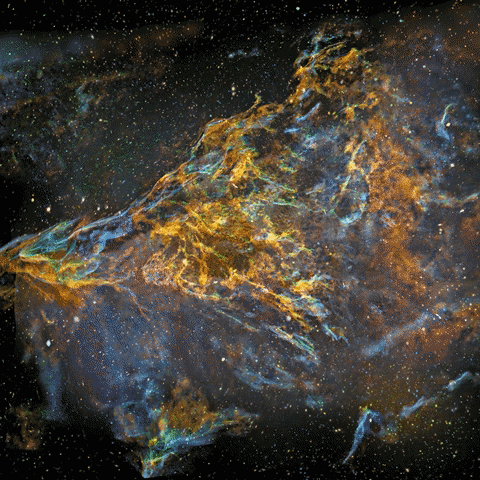COPYRIGHT, PLEASE NOTE
Friday, August 27, 2021
Visions of Veil
This is an experimental test with a 3D-conversion of my astronomical image. Only real elements from the original image are used, there is nothing added but the estimated volumetric information!
NOTE. This is a personal vision about shapes and volumes, based on some scientific data, deduction and an artistic impression.Tuesday, August 17, 2021
A starless Pickering's Triange
As far as I know, I was the first who published starless nebula images back in 2007. At the time the feedback was less than positive.
The reason to publish such a unorthodox images was that the starless version is a part of my processing workflow and it can sometimes show more than the actual image.
I have used this technique ever since and published some starless images now and then.
Starless images are very powerful, when I want to dig out some really dim objects in a very dense starfield. It makes processing so much easier, I don't need to be careful not to blow up the stars.
Normally all the stars are placed back with a zero data lost after processing is done.
Starless images are also a great help to see the actual structure in the nebula since human brains has a tendency to form a quasi logical shapes out of the random cloud of dots, like stars are.
Please, click for a large image, it's worth it!
https://astroanarchy.blogspot.com/2015/09/pickerings-triangle-my-first-light-for.html
Monday, August 9, 2021
Pickering's Triangle reprocessed with some new data
I originally shot this image at September 2015 and it was selected as a NASA APOD (Astronomy Picture of the Day) at same month.
I kind of like the result, colors are more vivid and background has deeper shades.
Please, click for a large image, it's worth it!
Colors are from the ionized elements, Hydrogen, Sulfur and Oxygen.
S-II = Red, H-alpha = Green and O-III = Blue.
Technical details and more images:
https://astroanarchy.blogspot.com/2015/09/pickerings-triangle-my-first-light-for.html
Sunday, August 1, 2021
A new photo, Monkey Head Nebula, Lower's nebula, Jelly Fish nebula and Messier 35
I shot material for this mosaic image at end of the spring season 2021. I haven't got time to finalize it until now. I kind of like this image, it's very deep and shows the very dim background mist and a very dense starfield of the galaxy plane. Total exposure time with Tokina AT-x 300mm f2,8 camera lens, Apogee u16 Astro camera and Astrodon narrowband filters is around 6 hours, the exposure time with Celestron Edge telescope is around 30 hours.
An other interesting feature in this imaging project is that I did use my VARES-processing method to this.
(Variable Resolution imaging) I have shot the nebulae in this wide field image with a long focal length instrument, the Celestron Edge 11" few years ago. I use this high res material to boost details in the wide field image. But that's not all!
I used the VARES technique to add deepness to my older long focal length images. I added the very dim background nebula data from wide filled images to long focal length images. The result was very good. Now all detailed features in the image, like stars, brighter nebula details and dark nebulae are form high res image data. The dim and relatively featureless data is taken from the wide field image. At the end the both datasets are combined by VARES-processing method to a one very deep and detailed image.
Click for a large image!
Monkey Head nebula, NGC 2175
Click for a large image
The wide field data boosted long focal length image, original photo and details can be seen here, https://astroanarchy.blogspot.com/2015/03/ngc-2174-monkey-head-nebula-project.html
I think, this was a first image in the World showing the extremely dim lower part, "Teil of the Monkey", of the nebula.
Click for a large image
Click for a large image





















